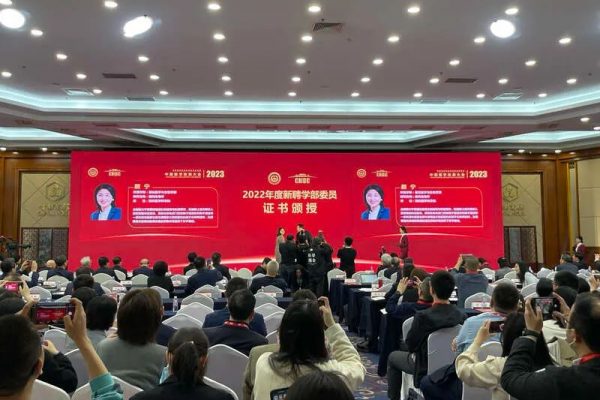Chip发表浙江大学戴道锌团队最新成果:超过110 GHz的超紧凑型铌酸锂微腔电光调制器
FUTURE远见| 2022-11-28
Future|远见
Future|远见future选编
超大带宽电光调制器是超高容量光互连、太赫兹无线通信和传感系统等应用中的核心器件。近年来,薄膜铌酸锂因其高电光系数、强光场限制和低传输损耗等优点已成为实现高性能电光调制器的最佳选择之一²⁻³。其挑战在于如何实现超紧凑尺寸、超低低功耗及超高速度等优异特性。
与马赫-泽德干涉仪调制器相比,微腔型调制器在器件尺寸、调制功耗等方面具有明显优势,还可同时实现波分复用和电光调制等功能。然而,基于薄膜铌酸锂波导实现微腔型电光调制器仍然具有非常高的挑战性。首先,铌酸锂晶体的各向异性可能造成模式杂化,难以实现紧凑弯曲波导⁴。相应地,铌酸锂薄膜环形腔通常需要数百微米的大弯曲半径。其次,由于各向异性,环形腔中铌酸锂弯曲波导的电光调制被削弱,因此已报道的铌酸锂微腔调制器通常利用环形跑道结构,利用两个长直波导部分进行电光调制。此时,铌酸锂电光调制器尺寸往往很大。因此,发展一种无弯曲结构的铌酸锂波导微腔尤为重要。最简单直观的设计是采用法布里-珀罗谐振腔(FP腔)。然而,对于传统FP腔,存在光反射回到输入端口,通常需要外接隔离器或者环行器,使得整体结构复杂。
戴道锌团队提出并实现了一种基于2×2 FP腔的新型铌酸锂电光调制器。该调制器巧妙地利用多模波导光栅中TE0-TE1模式转换以及TE0-TE1模式解复用,有效地将反射光与输入光相分离,无需外接隔离器或者环行器,极大地简化了总体结构⁵。论文对FP腔电光调制器进行了深入理论分析,讨论了其调制带宽和调制效率与微腔Q值及工作波长失谐的相关性,并研制了等效腔长仅~ 50 μm的2×2 FP腔调制器。理论表明,利用峰值增强效应⁶,该器件调制带宽可超过200 GHz。实验测得其3 dB带宽超过110 GHz(受限于实验设备),实现了首个带宽超110 GHz的微腔型薄膜铌酸锂电光调制器,并进一步实验演示了100 Gbps 开关键控(on-off keying, OOK)和140 Gbps PAM4信号产生,其能耗仅4.5 fJ bit⁻¹。理论和实验表明:该器件具有超小尺寸、超高带宽、超低能耗等优点,具有突出的应用潜力。
图2 | (a)谐振波长调制量与加载电压关系的实验测量结果;(b) 实验测量的小信号电光响应;(c) 不同波长失谐条件下的小信号电光响应理论计算结果。
Ultra-compact lithium niobate microcavity electro-optic modulator beyond 110 GHz ¹
An electro-optic (EO) modulator with a broad modulation bandwidth is highly desired for many applications, such as ultra-high-capacity optical interconnects, terahertz wireless communication, or sensing systems. More recently, the thin-film lithium-niobate-on-insulator (LNOI) has emerged as one of the most attractive options for high-performance EO modulation because of the advantages of high EO coefficient, strong optical confinement, and low loss ²⁻³.
As it is well known, high-speed EO modulators with a compact footprint and low power consumption are urgently needed to support the demands in many applications, including high-density optical interconnects. In contrast to Mach-Zehnder modulators (MZMs), microcavity-based EO modulators have been recognized as a very attractive option because of the potential to have footprint compactness as well as low power consumption. Furthermore, microcavity-based EO modulators can work simultaneously for wavelength division multiplexing and modulation. However, the realization of microcavity-based EO modulators on LNOI remains very challenging. First, the LN anisotropy makes it difficult to achieve sharp bends due to the possible mode hybridness⁴. Therefore, the LNOI micro-ring or racetrack usually has a bending radius as large as 100 μm. Second, the effective EO modulation in bending section is weakened due to the LN anisotropy. Thus, the reported LN microcavity modulators usually have to utilize the racetrack structure including two long straight sections for EO modulation. With this design, the LN EO modulators usually have a very large footprint. Therefore, it is very desirable to develop LN micro-cavities without any bending sections. A straightforward structure is using an FP cavity, which consists of straight sections only. However, for conventional FP cavities, the modulated light is reflected back to the input port, and thus an external circulator is usually required.
A lithium-niobate-on-insulator (LNOI) EO modulator based on a 2×2 FP-cavity is proposed and realized with an ultra-compact footprint as well as an ultra-high bandwidth, which can efficiently separate the input light and the reflected modulated optical signal with the help of the TE0-TE1 mode conversion in a multimode waveguide grating and the TE0-TE1 mode demultiplexing⁵. A comprehensive analysis of the present LNOI FP-cavity modulator is given to reveal the dependence of the modulation bandwidth as well as the modulation efficiency of the LNOI FP-cavity modulators on the cavity Q-factor and the operation wavelength detuning to the resonance. The designed LNOI FP-cavity modulator has an effective cavity length as short as ~ 50 μm. It is shown theoretically that the modulation bandwidth can be improved significantly to beyond 200 GHz by utilizing the peaking enhancement effect⁶. For the fabricated device, the measured 3-dB bandwidth is higher than 110 GHz (limited by the facilities in experiments). This is the first LNOI microcavity modulator with a 3-dB bandwidth of greater than 110 GHz, to our best knowledge. Finally, high-quality eye diagrams of 100 Gbps on-off keying (OOK) and 140 Gbps 4-pulse amplitude modulation (PAM4) signals are demonstrated experimentally, corresponding to an ultra-low energy consumption of 4.5 fJ bit⁻¹ for the OOK signals. The present LNOI FP-cavity modulators show great potential for applications due to the advantages of ultra-compact footprints, ultra-high bandwidths, and ultra-low energy consumption.
参考文献
[1]Pan, B.-C. et al. Ultra-compact lithium niobate microcavity electro-optic modulator beyond 110 GHz. Chip 1, 100029 (2022).
[2]Wang, C. et al. Integrated lithium niobate electro-optic modulators operating at CMOS-compatible voltages. Nature 562, 101–104 (2018).
[3]He, M. et al. High-performance hybrid silicon and lithium niobate Mach–Zehnder modulators for 100 Gbit s⁻¹ and beyond. Nat. Photonics 13, 359–364 (2019).
[4]Pan, B. et al. Compact racetrack resonator on LiNbO₃. J. Light. Technol. 39, 1770–1776 (2021).
[5]Pan, B. et al. Compact electro-optic modulator on lithium niobate. Photonics Res. 10, 697 (2022).
[6]Müller, J. et al. Optical peaking enhancement in high-speed ring modulators. Sci. Rep. 4, 6310 (2015).
原文链接
https://www.sciencedirect.com/science/article/pii/S2709472322000272
作者简介
戴道锌,浙江大学求是特聘教授/博士生导师、国家重点研发计划项目负责人、浙江省高水平创新团队负责人。2017年获国家杰出青年科学基金,2021年入选美国光学会(原OSA,现称Optica)会士(Fellow)。戴道锌教授现任浙江大学光电科学与工程学院院长、教育部光子学与技术国际联合实验室主任、Optical and Quantum Electronics期刊(Springer-Nature出版社)主编、Chip期刊(Elsevier-上海交通大学联合出版)创刊编委会成员。戴道锌团队长期致力于高性能高集成度硅基集成光子器件及其光通信/光互连等方面应用研究,在多模硅光子学、片上偏振调控、硅+光子学(Silicon-plus Photonics)等方面取得重要进展:
(1)率先提出了面向片上偏振调控的硅基非对称波导及耦合结构体系,实现超小型大带宽高性能硅基片上调控器件;
(2)突破了单模条件设计框架,引入高阶模构建了硅基多模光子学及功能器件;
(3)与金属、2D材料及聚合物等相融合,发展了硅+X异质集成光电子器件。谷歌学术显示,截至2022年11月底,戴道锌教授所著论文共被引用近16000次,h指数64。
戴道锌教授个人主页:
https://person.zju.edu.cn/dxdai
关于Chip
Chip是全球唯一聚焦芯片类研究的综合性国际期刊,已入选由中国科协、教育部、科技部、中科院等单位联合实施的「中国科技期刊卓越行动计划高起点新刊项目」,为科技部鼓励发表「三类高质量论文」期刊之一。
Chip期刊由上海交通大学与Elsevier集团合作出版,并与多家国内外知名学术组织展开合作,为学术会议提供高质量交流平台。
Chip秉承创刊理念: All About Chip,聚焦芯片,兼容并包,旨在发表与芯片相关的各科研领域尖端突破性成果,助力未来芯片科技发展。迄今为止,Chip已在其编委会汇集了来自13个国家的68名世界知名专家学者,其中包括多名中外院士及IEEE、ACM、Optica等知名国际学会终身会士(Fellow)。
Chip第四期将于2022年12月在爱思唯尔Chip官网以金色开放获取形式(Gold Open Access)发布,欢迎访问阅读文章。
爱思唯尔Chip官网:
https://www.journals.elsevier.com/chip

Warning: Invalid argument supplied for foreach() in /www/wwwroot/www.futureyuanjian.com/wp-content/themes/future/single-news.php on line 41



